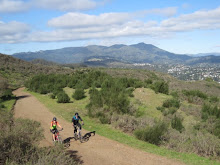
I don't usually go out of my way to destroy my hands, I mean absolutely tear them up. Don't worry, I'm not including a photo of their sad state. But a couple of weeks ago something made me MAD, I mean really MAD, and I did a very good job of wrecking my hands in the midst of that madness, leaving my paws blistered, battered, and aching from overuse. I had taken on a formidable enemy, armed with nothing but brute force, stubborn determination, and a crummy pair of gardening gloves. My enemy: broom.

Anyone living in--or even merely driving through--Marin this time of year can't miss broom. It's that lush shrub smothered in yellow flowers. You might even think it's pretty. But broom has become Public Plant Enemy #1 here, as it chokes out native plants and creates nasty fire hazards all over the county.
Broom most commonly grows in two forms in Marin: Scotch broom (tiny leaves growing on a tough stem, yellow flowers sometimes with tiny red polka dots near the flower's base).

Much more prominent is French broom (shown below, it's leafier, up to 5 or 6 feet tall, loaded with yellow flowers).

The plants are incredibly invasive, moving into cleared areas, burn sites, or really anywhere they see fit and taking over--fast. In a year a hillside can turn from nice leafy meadow dotted with wildflowers into a sloped choked with broom. It's estimated that over 100,000 acres of broom now clog California hills.

These Mediterranean natives have no problem elbowing their way into our ecosystem here. In addition to being remarkable hardy woody perennials and perfectly adapted to our monsoon/drought weather here in Marin, they have insanely effective means of reproducing.
Each flower produces a pod loaded with tiny black seeds. When they ripen in early summer and begin to dry, the pods snap open, flinging the seeds like tiny cannonballs from a catapult, ever increasing the spread of the plants. On any given hot day, if you're in an area with broom, listen for the snap-snap-snap of the pods springing open and flinging their seeds wide.

So back to my hands. I hate broom, and yank it out along trails throughout the county. I'm not alone in my loathing. The county hates it too, and has volunteer broom-cleaning days throughout Marin County Open Space public lands
(here's how to help). Volunteer groups like
Think Blue Marin pitch in; here Terra Linda Students yank out broom. (Thank you, Think Blue....)
 Marin Municipal Water District hates it,
Marin Municipal Water District hates it, and has launched assorted pilot programs to find out how best to kill broom, which has remarkably deep roots and doesn't like to die. MMWD has tried vinegar spritzes--doesn't work. Goats don't eat it. Poison works, but it's not acceptable on watershed lands. The best route appears to be good-ole elbow grease. The county has broom-yanking tools (the lady below looks far too happy using one), but even with these devices, the job is no fun.


Best to do it on damp days like we've had this winter, when the roots come out easiest.
That's what I decided to do on my little patch of hillside--yank yank yank--by hand and aided by loppers,

until I had completely cleared an area under a pretty live oak that I see out my window. I estimate I pulled about 3,000 (yes, a 3 and 3 zeros) plants.

Once choked with broom, the oak now has lots of clear space for natives, and even baby oaks, to move in. Turkeys and quail and other critters already forage there, in space that was once impenetrable and monocultured with broom. I will broadcast native wildflower seeds there come fall, and keep my eye on broom seedlings, which I'll rip out with morbid pleasure.

Die broom die.












































